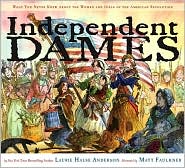 I recently had the opportunity to read and review Independent Dames by Laurie Halse Anderson. It's a nonfiction picture book focusing on the contributions of women to the American Revolution. And since Laurie and I are both independent dames who write nonfiction, and I recently interviewed her, I thought I'd discuss some of what I learned from writing biography and from talking to Laurie Halse Anderson about it.
I recently had the opportunity to read and review Independent Dames by Laurie Halse Anderson. It's a nonfiction picture book focusing on the contributions of women to the American Revolution. And since Laurie and I are both independent dames who write nonfiction, and I recently interviewed her, I thought I'd discuss some of what I learned from writing biography and from talking to Laurie Halse Anderson about it.One thing that Laurie does (which works well, I think) is to use approachable language. In fact, the narrator of Independent Dames and Thank You, Sarah has a decidedly irreverent tone. And where other information is presented (as in the bio bubbles in Independent Dames, she provides only the interesting bits, in concise, approachable language.
Another thing Laurie does well is to create a sense of the times by describing not just the actions of a person in isolation, but some of the setting (time, place, and other events) that were taking place, so that a reader understands not just the contribution of a particular woman, but something about the times in which she was living (and whether her actions flouted convention).
The Research Bit
Research is a key component of writing nonfiction (or historical fiction). Getting the details right is an important part of establishing credibility. As Laurie said:
Historical accuracy is vital to my work. My manuscripts have all been reviewed by historians whose special expertise is the time periods or events covered by my story. Most of the characters in my novels are fictional, but they are as true to what people were like back then as possible. When “real” people wander across the pages of my books, like George Washington, they only do or say things that I can prove they did or said. Laurie Halse Anderson, interview with Kelly Fineman
When researching the life of Jane Austen, I read biographies by other people, Austen's novels, Juvenilia and letters, books of literary criticism, historical accounts of life in Georgian and Regency England, books about locations in England, and more. I have spreadsheets to keep track of what books and articles I've read, and notebooks full of copies of articles from periodicals and web pages. I have written notes, often typed and backed up, but always kept together so I can find what I need. Organization is crucial when it comes to research. And so is knowing when enough is enough.
What I do for my Austen project is not unlike what Laurie Halse Anderson does when researching for a historical novel or nonfiction project:
It helps that I read quickly and I am rather compulsive about organization. I read constantly, both popular books about the time periods I care about and specialized historical journals. I belong to a number of history-based listservs and take advantage of the expertise of others. Once I have the broad outline of what I want to accomplish in a book, I delve into academic libraries, looking for the writings of historians who have made my topics their life’s work, and using their bibliographies as my guide to primary source materials. I keep copious notes and often have nightmares in which I am drowning in a sea of citations. Laurie Halse Anderson, interview.

No comments:
Post a Comment